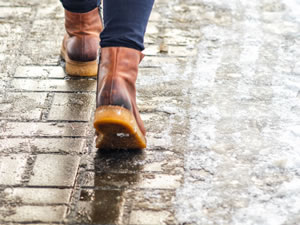Choosing Ice and Snow Melters to Minimize Damage
Don’t Let Ice and Snow Melters Destroy your Stone and Terrazzo Floors
By Fred Hueston, Stone Forensic Expert
The crystallization of deicing salts found in many snow and ice melter can cause severe deterioration of stone, terrazzo and masonry surfaces. This crystallization is called subflorescence. Snow and ice-melters containing calcium chloride, etc. are the cause for this damage. Problems associated with subflorescence can be diagnosed and identified by visual clues, such as spalling and pitting. Accurate diagnosis of subflorescence can be confirmed with laboratory testing. Preventative applications might include application of chemical injection and coating the masonry with a sealer or impregnator as well as switching to a snow and ice-melter that contain non-crystalline salts. The following article will explore the problems caused by these deicers and what can be done to prevent damage to your stone, terrazzo or masonry floors.
How Do Deicers Cause Damage?
The deposit of salts in the pores of stone and masonry is the major cause for deterioration of these surfaces. These salts are contained in many popular snow and ice melters.
Boyer (1986) contributes deicing salts
When snow and ice melts, the salts used in deicers become soluble. The water wicks into the pores of the stone and masonry carrying the salts with it. When the water evaporates the salts recrystallize. The pressure created in the pores of the stone and masonry cause the surface to flake off or spall. This process is known as subflorescence.
Diagnosing and Identifying Subflorescence
An experience stone consultant can recognize the signs and symptoms of damage caused by deicing salts. The stone and masonry will appear pitted (spalled). This damage is observed in the walking path at the entrances of the building. The damage tends to lessen the further away from the entrance. Certain stones such as some limestones and slates will flake off in sheets. Terrazzo and marble will become pitted.
Core samples can also be taken and sent to a lab for testing and verification if necessary.
Snow and Ice Melters
There are many brands of snow melters on the market. Many of these melters contain salts that will crystallize and cause damage to stone and masonry. The following are the salts you should avoid.
Rock Salt – Rock salt will go by the name of Halite but chemically it is simply Sodium Chloride (NaCl). This is the most common salt sold for deicing and it is also the least expensive and hence is the most widely used. It is also the salt that causes the most damage to stone, terrazzo and masonry flooring.
Calcium and Magnesium Chloride (CaCl2 –MgCl2) – These are salts that come from natural salt deposits in the Great Salt Lake in Utah. They are also destructive to stone, terrazzo and masonry. They also can deposit a film on the surface of the floor causing it to be slippery.
Potassium Chloride (KCL) – This salt is not a very good deicer by itself and is often found mixed with other ingredients. It is often sold as a safer salt for plants. But not for stone, terrazzo or masonry.
Ammonium Sulphate (NH42SO4) Stay far away from this salt. It is very damaging to stone, terrazzo and masonry. It’s not used much in deicers but if you see it listed on the ingredients, don’t buy it.
Urea – Urea is commonly found in fertilizers. In its pure form it is less damaging the most other salts. Most deicers containing urea are not pure, though, and can be damaging to stone, terrazzo and masonry.
The above salts are in a sold crystalline form. There are liquid deicers available containing Ethylene Glycol and Potassium Acetate but liquids are usually impractical to apply in schools and other public buildings.
Safe Deicers
Which salts are safe for stone, terrazzo and masonry flooring? Thanks to our many icy roads a salt known as Calcium Magnesium acetate was developed. Not only is this type of deicer more environmentally friendly it is also biodegradable, non-corrosive and less damaging to stone, terrazzo and masonry surfaces. The downside you might guess is the expense. But what will that new floor cost?
Safe for Concrete Deicers
The biggest concern with deicers is the corrosion of rebar in concrete. For this reason many deicers are claiming to be safe for concrete. This is true as far as less corrosion. Your concern is not necessarily corrosion but salt crystallization. Make sure to check the ingredient of these so called safer deicers by requesting a Material Safety Data Sheet (MSDS) or consult with a stone expert.
As I travel in areas where deicer are used I see thousands of schools, government buildings as well as public building with damage to stone, terrazzo and masonry flooring. If the damage is caught in time a restoration company may be able to repair the damage. If these harmful salts continue to be used, you’ll be replacing the flooring in a very short time.
This is one of a series of articles written and published on behalf of Surface Care PRO Partners.

